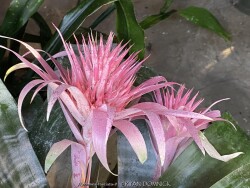

Silver Vase / Urn Plant (Aechmea fasciata) is an exotic-looking flowering plant from the bromeliad (Bromeliaceae) family. Despite its exotic appearance and tropical nature, this bromeliad adapts well to living as a potted house plant. In Kansas, use as a summer patio plant and protect from direct sunlight in mid summer and any temperatures below 50 degrees F in the spring or fall. As an epiphyte, much of its water needs are met by keeping the plants center "Urn" filled with water once per week or two. They have a shallow root systems and probably won't ever need repotted. When flowering, the flowers themselves are short-lived, but the pink and red bracts last for a few months.
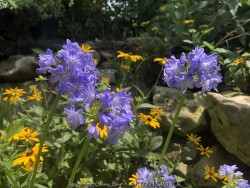

Agapanthus are typically grown in warmer zones, but Walters Gardens has introduced a collection of vigorous varieties that are hardy to zone 6! Agapanthus 'Galaxy Blue' was originally tested in Michigan and overwintered for the more than 7 years. They also survived the Kansas cold blast of February 2021 (temperatures reaching -16 degrees F) with no problems. They're out of this world with globular clusters that are produced on tall stems over large, rounded clumps of foliage. 4" clusters of dark blue flowers are produced and rebloom occurs if watered regularly in the summer. True blue is an especially rare flower color in the garden. Foliage resembles daylilies and turns yellow in the fall. To be safe with any "hardy tropical", apply a heavy 3-4"mulch layer for the first few years.
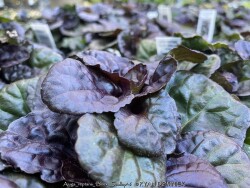

Ajugas are extremely hardy groundcovers that quickly form a dense carpet-like mat. Unlike many perennials that are grown only for their flowers, Ajuga is prized for its attractive, evergreen colorful foliage that looks nice all year. The deepest foliage color is achieved when plants are sited in full sun and in cooler temperatures although in Kansas this may result in foliage burning in summer if not adequately watered. From mid to late spring, short deep blue flower spikes stand upright above the foliage. Do not allow foliage to be covered with leaves or mulch during winter or crown rot disease may occur wiping out large patches. Ajuga reptans 'Black Scallop' tends to spread more slowly and stay naturally compact compared to other varieties of Ajuga, making it suitable for use as an edging, rock gardens, walking trails borders and mixed container plantings. This attractive small-scale variety has glossy, near-black, scalloped leaves and a dense habit.
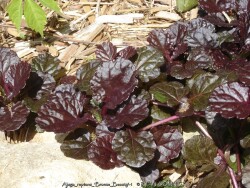

Ajugas are extremely hardy groundcovers that quickly form a dense carpet-like mat. Unlike many perennials that are grown only for their flowers, Ajuga is prized for its attractive, evergreen colorful foliage that looks nice all year. The deepest foliage color is achieved when plants are sited in full sun and in cooler temperatures although in Kansas this may result in foliage burning in summer if not adequately watered. From mid to late spring, short deep blue flower spikes stand upright above the foliage. Do not allow foliage to be covered with leaves or mulch during winter or crown rot disease may occur wiping out large patches. Ajuga reptans 'Bronze Beauty' tends to spread more slowly and stay naturally compact compared to other varieties of Ajuga, making it suitable for use as an edging, rock gardens, walking trails borders and mixed container plantings. This attractive small-scale variety has glossy, purplish-black, shiny leaves and a dense habit.
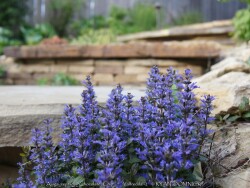

Ajugas are extremely hardy groundcovers that quickly form a dense carpet-like mat. Unlike many perennials that are grown only for their flowers, Ajuga is prized for its attractive, evergreen colorful foliage that looks nice all year. The deepest foliage color is achieved when plants are sited in full sun and in cooler temperatures although in Kansas this may result in foliage burning in summer if not adequately watered. From mid to late spring, short deep blue flower spikes stand upright above the foliage. Do not allow foliage to be covered with leaves or mulch during winter or crown rot disease may occur wiping out large patches. Ajuga reptans 'Chocolate Chip' / 'Valfredda' is the smallest and tends to spread more slowly and stay naturally compact compared to other varieties of Ajuga, making it suitable for use as an edging, rock gardens, walking trails borders and mixed container plantings. This attractive small-scale variety has tiny carpetlike purple leaves and a dense habit.
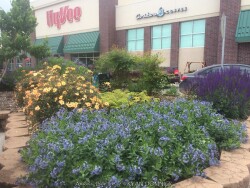

Blue Ice Amsonia (Amsonia 'Blue Ice') is a chance seedling from A. tabernaemontana which is native to North America. It bears gorgeous deep blue buds in late spring opening to vivid a periwinkle blue for about 4-6 weeks. The bright green foliage is compact and mostly pest-free. However in some years with high humidity and extra summer rainfall, the foliage gets diseased and should be cut back early. If in good air circulation, the foliage often turns a rich shade of yellow in fall characteristic of most amsonias. In Kansas Landscapes, it is usually planted as a mass groundcover growing into a dense weed proof mass. Established plants are low maintenance and almost never need to be replaced, divided or watered.


The species bluestar (Amsonia) grows up to 3 feet tall and prefers a medium to moist soil, but will tolerate a range of soils in light shade, including clay. "Once it's there, it's there forever" plant! Native to East-central U.S. in open woodlands and sunny plains. 'Storm Cloud' is and improved selection with new stems emerge near-black with leaves that are very dark green with silver veins. The stems stay dark throughout spring contrasting the light periwinkle blue, star-shaped flowers that completely cover the foliage by late spring. Some reblooming may occur for many weeks afterward. Although the main interest of this plant is in spring, it maintains a great garden presence throughout the summer and fall. Its wide, mounded habit lends itself well to be used in place of shrubs in the landscape. In some years with high humidity and extra summer rainfall, the foliage gets diseased and should be cut back early. Provide planting location with good air circulation to avoid this small problem. Compared to 'Storm Cloud', Amsonia 'Starstruck', a more compact version at 18", has wider leaves, and blooms about 1-2 weeks later in the spring. All Proven Winners® plants are legally propagated, healthy and vigorous, true to name, and tagged with color pictures and growing information.
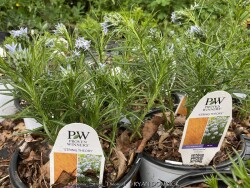

Narrow-leaf Amsonia (Amsonia hubrichtii) is clump-forming plant that is primarily grown in cultivation for its feathery green summer foliage and golden fall color. Spring flowers are powdery blue rising on 3' stalks creating a compact dense willow-like bush. The blooming season is relatively short but the pinnately compound leaves offers lasting interest and a "Wow" factor. Rich golden fall color is long-lasting and dries remaining attractive deep into the winter. No deadheading is needed and the only maintenance is cutting the plant back each winter after the fall foliage is no longer attractive. In some years with high humidity and extra summer rainfall, the foliage gets diseased and should be cut back early. Provide planting location in full sun with good air circulation to avoid this small problem. The growth is so dense that no weeds have a chance of invading a mature stand of plants. Amsonia hubrichtii is relatively new to cultivation being discovered in Arkansas in 1942 but is hardy in zones 5-9. Combine with other summer or fall flowering plants like hardy hibiscus, crapemyrtle, or penstemon. Fine-textured foliage also combines well with dark foliage, larger leaves, and dark colored walls! Great for large-scale mass plantings needing something permanent. This is a true four-seasons long-lived perennial that belongs in almost every perennial garden. String Theory Narrow-leaf Amsonia (Amsonia 'String Theory') can be described as a compact version of the industry standard Amsonia hubrichtii. All Proven Winners® plants are legally propagated, healthy and vigorous, true to name, and tagged with color pictures and growing information.
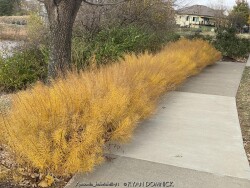

Narrow-leaf Amsonia (Amsonia hubrichtii) is clump-forming plant that is primarily grown in cultivation for its feathery green summer foliage and golden fall color. Spring flowers are powdery blue rising on 3' stalks creating a compact dense willow-like bush. The blooming season is relatively short but the pinnately compound leaves offers lasting interest and a "Wow" factor. Rich golden fall color is long-lasting and dries remaining attractive deep into the winter. No deadheading is needed and the only maintenance is cutting the plant back each winter after the fall foliage is no longer attractive. In some years with high humidity and extra summer rainfall, the foliage gets diseased and should be cut back early. Provide planting location in full sun with good air circulation to avoid this small problem. The growth is so dense that no weeds have a chance of invading a mature stand of plants. Amsonia hubrichtii is relatively new to cultivation being discovered in Arkansas in 1942 but is hardy in zones 5-9. Combine with other summer or fall flowering plants like hardy hibiscus, crapemyrtle, or penstemon. Fine-textured foliage also combines well with dark foliage, larger leaves, and dark colored walls! Great for large-scale mass plantings needing something permanent. This is a true four-seasons long-lived perennial that belongs in almost every perennial garden.
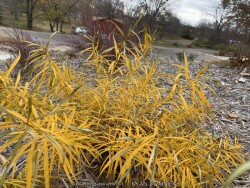

Narrow-leaf Amsonia (Amsonia hubrichtii) is clump-forming plant that is primarily grown in cultivation for its feathery green summer foliage and golden fall color. Spring flowers are powdery blue rising on 3' stalks creating a compact dense willow-like bush. The blooming season is relatively short but the pinnately compound leaves offers lasting interest and a "Wow" factor. Rich golden fall color is long-lasting and dries remaining attractive deep into the winter. No deadheading is needed and the only maintenance is cutting the plant back each winter after the fall foliage is no longer attractive. In some years with high humidity and extra summer rainfall, the foliage gets diseased and should be cut back early. Provide planting location in full sun with good air circulation to avoid this small problem. The growth is so dense that no weeds have a chance of invading a mature stand of plants. Amsonia hubrichtii is relatively new to cultivation being discovered in Arkansas in 1942 but is hardy in zones 5-9. Combine with other summer or fall flowering plants like hardy hibiscus, crapemyrtle, or penstemon. Fine-textured foliage also combines well with dark foliage, larger leaves, and dark colored walls! Great for large-scale mass plantings needing something permanent. This is a true four-seasons long-lived perennial that belongs in almost every perennial garden. Butterscotch Amsonia (Amsonia hubrichtii 'Butterscotch') is like other Amsonia in general appearance, but with improved form, reddish stems, superior rich "butterscotch" fall color, and great resistance to tip dieback. Flower color is also slightly darker blue.


Shining bluestar (Amsonia illustris) grows up to 3 feet tall and prefers a medium to moist soil, but will tolerate a range of soils in light shade, including clay. "Once it's there, it's there forever" plant! Native to Central U.S. most frequently occuring in sandy or rocky soils on gravel bars or along streams. Because it tolerates periods of brief flooding, it is an ideal amsonia for the rain-garden. This is a great amsonia for foliage quality, bearing Narrow, willow-shaped, leathery, shiny green leaves.
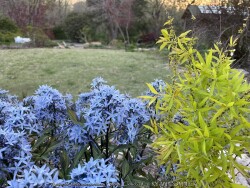

The species bluestar (Amsonia tabernaemontana) growing up to 3 feet tall and prefers a medium to moist soil, but will tolerate a range of soils in light shade, including clay. "Once it's there, it's there forever" plant! Native to East-central U.S. in open woodlands and sunny plains. Amsonia tabernaemontana 'Storm Cloud' is and improved selection with new stems emerge near-black with leaves that are very dark green with silver veins. The stems stay dark throughout spring contrasting the light periwinkle blue, star-shaped flowers that completely cover the foliage by late spring. Some reblooming may occur for many weeks afterward. Although the main interest of this plant is in spring, it maintains a great garden presence throughout the summer and fall. Its wide, mounded habit lends itself well to be used in place of shrubs in the landscape. In some years with high humidity and extra summer rainfall, the foliage gets diseased and should be cut back early. Provide planting location with good air circulation to avoid this small problem.
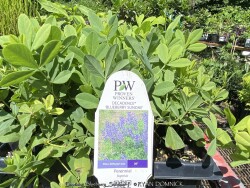

The False Indigo species (Baptisia) features beautiful compact bluish green leaves arranged in groups of three. Like many members in the legume family, they are nitrogen fixing plants which means they produce their own nitrogen in the soil through a symbiotic relationship with bacteria. The flowers bloom above the foliage normally in April and May. Common baptisia flower colors include white, purple, lavender, yellow, and pink as well as uncommon colors ranging from deep purple to maroon and even coppery orange. Considered a great North American native three season plant, the foliage always emerges very attractive followed by flowers that do not need deadheading. Foliage generally lasts pretty nice through hot summers and into fall turning black with first freeze. Seed pods also turn charcoal black when ripe and have considerable ornamental interest and useful in dried flower arrangements. At some point in the fall, it can be cut down early for a clean look or left for winter interest. Baptisia generally do well in droughty clay soils in full to part sun. There is only one pest that may create problems called the Genista Broom Moth. It may occur in Kansas when weather conditions are consistently dry and over 95 degrees F. It is treatable if you act fast but if not, it only destroys the foliage late in the season and does not kill the plant. Baptisia has several enormous spreading taproots which store water and energy and can make transplanting difficult. Plantings look good as specimen or in small groups; and it's ok even preferable if they grow together and touch other plants. That helps eliminate available sunlight and discourages weeds. It is hard to picture a native plant garden or any perennial garden without Baptisia. Considered a once "it's there, it's always there" long lived plant. Baptisia 'Blueberry Sundae' features deep indigo blue flowers much more vibrant than the original species B. australis. The deep blue-green foliage forms a more compact, upright mound to 3' tall at maturity. 'Blueberry Sundae' is a vigorous grower and the foliage looks great all summer. Ornamental seed pods extend the season of interest into fall. This plant is a member of the DECADENCE® series from Walters Gardens, Inc.


The False Indigo species (Baptisia) features beautiful compact bluish green leaves arranged in groups of three. Like many members in the legume family, they are nitrogen fixing plants which means they produce their own nitrogen in the soil through a symbiotic relationship with bacteria. The flowers bloom above the foliage normally in April and May. Common baptisia flower colors include white, purple, lavender, yellow, and pink as well as uncommon colors ranging from deep purple to maroon and even coppery orange. Considered a great North American native three season plant, the foliage always emerges very attractive followed by flowers that do not need deadheading. Foliage generally lasts pretty nice through hot summers and into fall turning black with first freeze. Seed pods also turn charcoal black when ripe and have considerable ornamental interest and useful in dried flower arrangements. At some point in the fall, it can be cut down early for a clean look or left for winter interest. Baptisia generally do well in droughty clay soils in full to part sun. There is only one pest that may create problems called the Genista Broom Moth. It may occur in Kansas when weather conditions are consistently dry and over 95 degrees F. It is treatable if you act fast but if not, it only destroys the foliage late in the season and does not kill the plant. Baptisia has several enormous spreading taproots which store water and energy and can make transplanting difficult. Plantings look good as specimen or in small groups; and it's ok even preferable if they grow together and touch other plants. That helps eliminate available sunlight and discourages weeds. It is hard to picture a native plant garden or any perennial garden without Baptisia. Considered a once "it's there, it's always there" plant. According to Walters Gardens, Baptisia 'Violet Dusk' features "lavender violet flowers with cream keels makes this a stunning display for the early season garden. Its claim to fame is its unique vase-like habit. Although this plant is 3' wide, the base of the plant takes up a relatively small footprint, leaving space to under plant with other perennials. In comparison to other Baptisia in our trials, 'Violet Dusk' is relatively late to bloom." This extremely long-lived perennial could be used instead of a shrub in landscape settings, with minimal care required to thrive year after year.
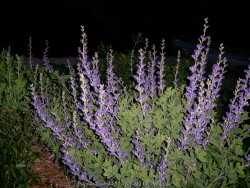

False Indigo (Baptisia australis) features beautiful compact bluish green leaves arranged in groups of three. Like many members in the legume family, they are nitrogen fixing plants which means they produce their own nitrogen in the soil through a symbiotic relationship with bacteria. The flowers bloom above the foliage normally in April and May. Common baptisia flower colors include white, purple, lavender, yellow, and pink as well as uncommon colors ranging from deep purple to maroon and even coppery orange. Considered a great North American native three season plant, the foliage always emerges very attractive followed by flowers that do not need deadheading. Foliage generally lasts pretty nice through hot summers and into fall turning black with first freeze. Seed pods also turn charcoal black when ripe and have considerable ornamental interest and useful in dried flower arrangements. At some point in the fall, it can be cut down early for a clean look or left for winter interest. Baptisia generally do well in droughty clay soils in full to part sun. There is only one pest that may create problems called the Genista Broom Moth. It may occur in Kansas when weather conditions are consistently dry and over 95 degrees F. It is treatable if you act fast but if not, it only destroys the foliage late in the season and does not kill the plant. Baptisia has several enormous spreading taproots which store water and energy and can make transplanting difficult. Plantings look good as specimen or in small groups; and it's ok even preferable if they grow together and touch other plants. That helps eliminate available sunlight and discourages weeds. It is hard to picture a native plant garden or any perennial garden without Baptisia. Considered a once "it's there, it's always there" plant.
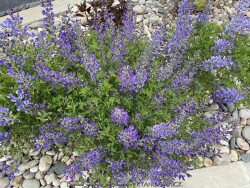

False Indigo features beautiful compact bluish green leaves arranged in groups of three. Like many members in the legume family, they are nitrogen fixing plants which means they produce their own nitrogen in the soil through a symbiotic relationship with bacteria. The flowers bloom above the foliage normally in April and May. Common baptisia flower colors include white, purple, lavender, yellow, and pink as well as uncommon colors ranging from deep purple to maroon and even coppery orange. Considered a great North American native three season plant, the foliage always emerges very attractive followed by flowers that do not need deadheading. Foliage generally lasts pretty nice through hot summers and into fall turning black with first freeze. Seed pods also turn charcoal black when ripe and have considerable ornamental interest and useful in dried flower arrangements. At some point in the fall, it can be cut down early for a clean look or left for winter interest. Baptisia generally do well in droughty clay soils in full to part sun. There is only one pest that may create problems called the Genista Broom Moth. It may occur in Kansas when weather conditions are consistently dry and over 95 degrees F. It is treatable if you act fast but if not, it only destroys the foliage late in the season and does not kill the plant. Baptisia has several enormous spreading taproots which store water and energy and can make transplanting difficult. Plantings look good as specimen or in small groups; and it's ok even preferable if they grow together and touch other plants. That helps eliminate available sunlight and discourages weeds. It is hard to picture a native plant garden or any perennial garden without Baptisia. Considered a once "it's there, it's always there" plant. Baptisia australis var. minor has a shorter and more compact stature, being native to drier Western areas compared to the species. This includes Central and Eastern Kansas, Oklahoma, Texas, and Nebraska.
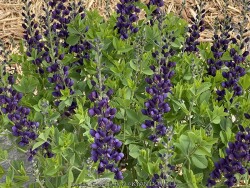

False Indigo (Baptisia) features beautiful compact bluish green leaves arranged in groups of three. Like many members in the legume family, they are nitrogen fixing plants which means they produce their own nitrogen in the soil through a symbiotic relationship with bacteria. The flowers bloom above the foliage normally in April and May. Common baptisia flower colors include white, purple, lavender, yellow, and pink as well as uncommon colors ranging from deep purple to maroon and even coppery orange. Considered a great North American native three season plant, the foliage always emerges very attractive followed by flowers that do not need deadheading. Foliage generally lasts pretty nice through hot summers and into fall turning black with first freeze. Seed pods also turn charcoal black when ripe and have considerable ornamental interest and useful in dried flower arrangements. At some point in the fall, it can be cut down early for a clean look or left for winter interest. Baptisia generally do well in droughty clay soils in full to part sun. There is only one pest that may create problems called the Genista Broom Moth. It may occur in Kansas when weather conditions are consistently dry and over 95 degrees F. It is treatable if you act fast but if not, it only destroys the foliage late in the season and does not kill the plant. Baptisia has several enormous spreading taproots which store water and energy and can make transplanting difficult. Plantings look good as specimen or in small groups; and it's ok even preferable if they grow together and touch other plants. That helps eliminate available sunlight and discourages weeds. It is hard to picture a native plant garden or any perennial garden without Baptisia. Considered a once "it's there, it's always there" plant. Many different cultivars and flower colors are available.
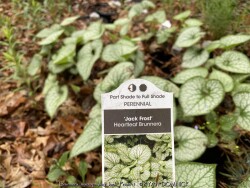

***Description for this perennial available with future update!***


***Description for this perennial available with future update!***
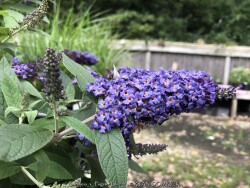

Butterfly Bush (Buddleia) are workhorses in the pollinator garden. Flower panicles come in a variety of colors mostly including shades of lavender, magenta, violet, pink, and white. Most Butterfly Bushes bloom on new wood so trimming off winter kill or complete rejuvenation will not affect flowering. In fact, flowering is often bigger and bolder from new water sprout growth when trimmed to the ground each year. Most Butterfly Bushes in zone 6 are maintained this way. Foliage is typically an attractive greenish-gray to mint green and persists into the fall until hard freezes occur. Use in the landscape in small or large groupings for its amazing flower power! Plants grow best in full sun with medium to dry soils. Drought tolerance is high with established plants so extra watering is rarely needed in our East Kansas climate with 40 inches of rain per year. Obviously, Butterfly Bush attracts lots of butterflies. There has been some debate in recent years on whether to plant Butterfly Bush because it's a non-native plant. Being a native of China, it has no pest or disease problems here. It is invasive in some parts of the country but cold Kansas winters keep it and check and without any self-seeding problems here. If you are still worried about it, there are several sterile varieties to choose from. There have been many drastically improved cultivars in the last 10 years aiming to improve cold hardiness, bloom size, eliminate seeding, and improve growth habits. Buddleia x 'Pugster Blue' is a compact Butterfly Bush reaches just 2-3' tall and wide but has the large, full flowers normally seen on a much larger plant. It blooms non-stop from early summer through frost with true-blue flowers, each with a tiny yellow-orange eye in the center. Thanks to thick, sturdy stems, the Pugster® series offers vastly improved hardiness and winter survival over other types of dwarf Butterfly Bush. Thanks to its long-blooming habit, Pugster Butterfly Bushes add low-maintenance color to any sunny spot in your yard. The name "Pugster" comes from these plants' resemblance to a pug - short, stocky, and cute! In Eastern Kansas, this cultivar performs WELL with just about everything nature has to challenge it! Heat and drought are tolerated. Cold tolerance is no problem in our zone 6. If winter die-back occurs, cut back in March/April and flowers will occur on new growth this year. No disease or pest problems. Combine with caryopteris and crapemyrtle to create a late season "all you can eat" buffet for pollinators! All Proven Winners® plants are legally propagated, healthy and vigorous, true to name, and tagged with color pictures and growing information.
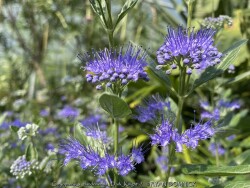

Dark Knight Caryopteris (Caryopteris x clandonensis 'Dark Knight') features darker green summer foliage followed by late-summer deep blue flowers and a compact growing habit. It adds much-needed color to the late summer landscape and makes a handsome companion with perennials. A great favorite with pollinators of all types (bees, butterflies, and hummingbirds) in the late season garden. Caryopteris demands a sunny spot and very well-drained soil. Wet soils, particularly those that remain soggy during periods of cold weather, will cause root rot. For this reason, we recommend early season planting of caryopteris in zones 5. In Eastern Kansas, this cultivar performs WELL with just about everything nature has to challenge it! Heat and drought are tolerated well. Cold tolerance is no problem for us in zone 6. Caryopteris gives great winter interest with it's dried flowers. The only maintenance this shrub needs is cutting back about 1/2 way in early spring before new growth emerges. No disease or pest problems. Great plant for berms or hot West or South exposures in full sun. Do not plant in rich moist soils or root rot will probably occur. Even when not blooming, the compact green foliage looks good on it's own or combines well with earlier season blooming red, purple, blue, or magenta flowering plants. Combine with crapemyrtles and butterflybush to create a late season "all you can eat" buffet for pollinators!
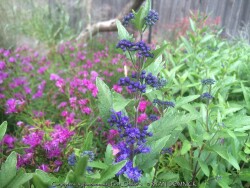

First Choice Caryopteris (Caryopteris x clandonensis 'First Choice') blooms earlier than other earlier caryopteris. This shrub develops a compact, tight habit with dark green foliage and deep blue long-lasting flowers. In Eastern Kansas, this cultivar performs WELL with just about everything nature has to challenge it! Heat and drought are tolerated well. Cold tolerance is no problem for us in zone 6. Caryopteris gives great winter interest with it's dried flowers. The only maintenance this shrub needs is cutting back about 1/2 way in early spring before new growth emerges. No disease or pest problems. Great plant for berms or hot West or South exposures in full sun. Do not plant in rich moist soils or root rot will probably occur. Even when not blooming, the compact green foliage looks good on it's own or combines well with earlier season blooming red, purple, blue, or magenta flowering plants. Combine with crape myrtles and butterfly bush to create a late season "all you can eat" buffet for pollinators!


Sunshine Blue® II Bluebeard (Caryopteris x clandonensis 'Sunshine Blue II') is the hardiest caryopteris yet! Sunshine Blue II is a new, improved variety of the classic Sunshine Blue, but it's much more tolerant of cold climates. If you've had trouble with bluebeard surviving winter in your area in the past, now's your chance to enjoy the vivid gold foliage and blue blooms of this late blooming favorite. An excellent plant for attracting pollinators! Top reasons to grow Sunshine Blue II caryopteris: 1.The hardiest caryopteris yet - survives winter even in the Midwest. 2.Colorful all season, especially late in summer when blue flowers appear. 3.Thrives in hot, dry, sunny spots. Maintenance Notes: Plant bluebeard in full sun and well-drained soil. Though Sunshine Blue II tolerates colder conditions than other caryopteris, it will do best if you avoid planting it in spots where the soil is cold or wet in winter and early spring. Cut back hard in spring, after the new growth emerges. Avoid late season planting in coldest parts of its hardiness range. In Eastern Kansas, this cultivar performs WELL with just about everything nature has to challenge it! Heat and drought are tolerated well. Cold tolerance is no problem for us in zone 6. Caryopteris gives great winter interest with it's dried flowers. The only maintenance this shrub needs is cutting back about 1/2 way in early spring before new growth emerges. No disease or pest problems. Great plant for berms or hot West or South exposures in full sun. Do not plant in rich moist soils or root rot will probably occur. Even when not blooming, the intense gold foliage looks good on it's own or combines well with earlier season blooming red, purple, blue, or magenta flowering plants. Combine with crapemyrtles and butterflybush to create a late season "all you can eat" buffet for pollinators! All Proven Winners® plants are legally propagated, healthy and vigorous, true to name, and tagged with color pictures and growing information.
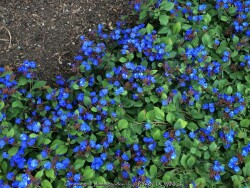

Creeping Plumbago / Leadwort (Ceratostigma plumbaginoides) is a Chinese native plant well adapted to our climate without being invasive in Kansas. It features nonstop royal blue flowers from midsummer till hard freeze; Usually three months or more. After a first light freeze, if flowering is still occurring, rich green foliage will turn bright red while still containing a few blue flowers. This creates a one-of-a-kind contrast not seen in any other plants. Plumbago combines well with just about any other plant due to its rare flower color. This is especially dramatic is combining it with opposites on the color wheel like orange, red or yellow. Growth is often slow to emerge in the spring as plumbago needs warmer soil than most other plants to start growing. This allows for a good combination for spring bulbs to grow with plumbago coming up later to hide the dying bulb foliage. In Kansas landscapes, plumbago is often used as a full sun groundcover in hot areas such as west or south side of the house. Normal garden conditions and berms are fine as well. Plants can survive and flower in shade but growth will be much slower and risk of death will be present until established. In zone 6a, all plantings should be mulched and only larger size established pots should be planted if in the fall. Plumbago sold in flats of many smaller plants can safely be planted in spring or summer. Plumbago needs medium to dry soil tolerating clay as long as everything as well-drained. Once plants are established for a season or two in full sun, they are nearly indestructible. Slow spread will occur and plants will develop very high density smothering out weeds. Sometimes the slowly spreading growth (underground rhizones) can be a problem after a decade or so. However, if you plan ahead and use it as a groundcover like intended, it will be perfect. Being a very low maintenance plant not requiring extra watering or deadheading, the only thing you need to do is weed-eat or cut back all the foliage in the winter. Plumbago has no pest or disease problems.
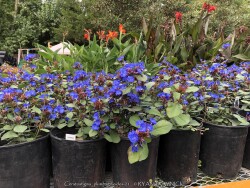

Creeping Plumbago / Leadwort (Ceratostigma plumbaginoides) is a Chinese native plant well adapted to our climate without being invasive in Kansas. It features nonstop royal blue flowers from midsummer till hard freeze; Usually three months or more. After a first light freeze, if flowering is still occurring, rich green foliage will turn bright red while still containing a few blue flowers. This creates a one-of-a-kind contrast not seen in any other plants. Plumbago combines well with just about any other plant due to its rare flower color. This is especially dramatic is combining it with opposites on the color wheel like orange, red or yellow. Growth is often slow to emerge in the spring as plumbago needs warmer soil than most other plants to start growing. This allows for a good combination for spring bulbs to grow with plumbago coming up later to hide the dying bulb foliage. In Kansas landscapes, plumbago is often used as a full sun groundcover in hot areas such as west or south side of the house. Normal garden conditions and berms are fine as well. Plants can survive and flower in shade but growth will be much slower and risk of death will be present until established. In zone 6a, all plantings should be mulched and only larger size established pots should be planted if in the fall. Plumbago sold in flats of many smaller plants can safely be planted in spring or summer. Plumbago needs medium to dry soil tolerating clay as long as everything as well-drained. Once plants are established for a season or two in full sun, they are nearly indestructible. Slow spread will occur and plants will develop very high density smothering out weeds. Sometimes the slowly spreading growth (underground rhizones) can be a problem after a decade or so. However, if you plan ahead and use it as a groundcover like intended, it will be perfect. Being a very low maintenance plant not requiring extra watering or deadheading, the only thing you need to do is weed-eat or cut back all the foliage in the winter. Plumbago has no pest or disease problems.
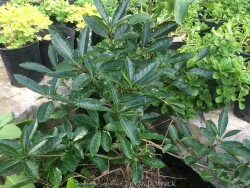

Fringe Tree, is also known as Chionanthus virginicus
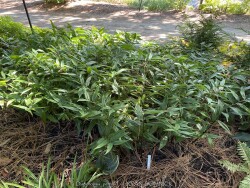

Evergreen Solomon's seal (Disporopsis pernyi) is planted for its evergreen dark green foliage and white flowers. Foliage maintains well all year provided that certain cultural conditions are met. Native to shaded mountain areas in forests, valleys or along streams in southern China, it needs constantly moist soil rich in organic matter avoiding too much clay. If low temperatures hit -10 degrees F, foliage finally dies back to the ground and re-emerges in early spring. Generally this plant can decline after a few years of Kansas climate but is worth a try in perfect soils in well-tended shade gardens. If low temperatures hit -10 degrees F, it may kill an un-mulched plant; protect any zone 6 perennial with thick layer of mulch. Lack of moisture and competition with weeds seem to be an issue but it survives just fine but never gets very dense. This is however, one of the most deep shade tolerant plants available.
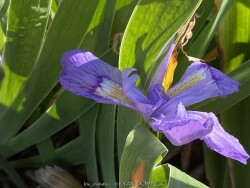

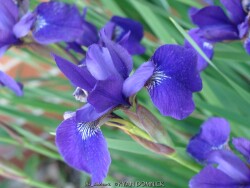

>>>>>This plant can also be used as a marginal aquatic plant growing in shallow water. It can also grow as a bog plant needing constantly moist soil rich in organic matter. As a rain garden plant, it will thrive is a depressed area in the landscape that collects rain water from a roof during spring and summer periods of rain but then go dormant if the water hole dries out completely.
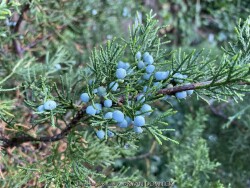

Eastern Red Ceder, is also known as Juniperus virginiana


Big Blue Liriope (Liriope muscari 'Big Blue') grows to form a dense, dark green, grass-like groundcover in medium to full shade. As one of the very best "dry-shade" plants, it has environmental and economic traits that can help conserve water and lower your water bill! Plantings can thrive for decades if in the right spot; there is no such thing as overcrowding for Liriope. When planted in mass, growth is slow at first but eventually a cake-like rhizome system will form and completely smother out any weeds and compete well with trees for water and nutrients. Even under the most hostile conditions such as huge silver maple and pin oak trees, liriope not only survives but thrives. While Big Blue Liriope can tolerate full sun, they prefer part to full shade. Sun burning is possible with temperatures over 100° and there are better plants to use in hot areas. Liriope has no insect or disease problems, will survive droughts, short-term floods and cold winters. In the winter, it will stay green until 0 degrees F and be completely evergreen some winters. Liriope also thrives in summer with the worst heat and humidity even in the Southeast and Southwest! Liriope is tolerant of a wide range of soil types but prefers clay/loam and will display best growth in fertile soils with average water but extremely drought tolerant in shaded areas! For the home garden, the species spreads slowly so you shouldn't leave very much room in-between Liriope plants or you will be waiting many years for the patch to fill in. Weeds can be a problem in that open area between plants if spacing is too wide. We recommend 12-18" spacing for a larger area. The only problem we have seen is a mysterious crown-rot disease in well-irrigated gardens. This liriope (Liriope muscari 'Big Blue') does not spread very quickly or much at all compared to Spreading Liriope / Monkey Grass (Liriope spicata) This is a real trooper for the dry shade garden!
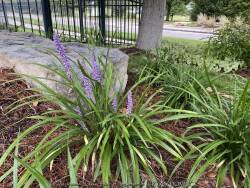

Classic Blue Clump-forming Liriope (Liriope muscari 'Classic Blue' / 'Ingwersen') grows to form a dense, dark green, grass-like groundcover in medium to full shade. As one of the very best "dry-shade" plants, it has environmental and economic traits that can help conserve water and lower your water bill! Plantings can thrive for decades if in the right spot; there is no such thing as overcrowding for Liriope. When planted in mass, growth is slow at first but eventually a cake-like rhizome system will form and completely smother out any weeds and compete well with trees for water and nutrients. Even under the most hostile conditions such as huge silver maple and pin oak trees, liriope not only survives but thrives. While Big Blue Liriope can tolerate full sun, they prefer part to full shade. Sun burning is possible with temperatures over 100° and there are better plants to use in hot areas. Liriope has no insect or disease problems, will survive droughts, short-term floods and cold winters. In the winter, it will stay green until 0 degrees F and be completely evergreen some winters. Liriope also thrives in summer with the worst heat and humidity even in the Southeast and Southwest! Liriope is tolerant of a wide range of soil types but prefers clay/loam and will display best growth in fertile soils with average water but extremely drought tolerant in shaded areas! For the home garden, the species spreads slowly so you shouldn't leave very much room in-between Liriope plants or you will be waiting many years for the patch to fill in. Weeds can be a problem in that open area between plants if spacing is too wide. We recommend 12-18" spacing for a larger area. The only problem we have seen is a mysterious crown-rot disease in well-irrigated gardens. This liriope (Liriope muscari 'Classic Blue' / 'Ingwersen') does not spread very quickly or much at all compared to Spreading Liriope / Monkey Grass (Liriope spicata) This is a real trooper for the dry shade garden!
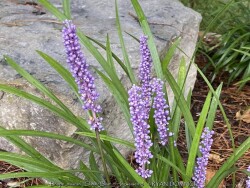

Classic Blue Clump-forming Liriope (Liriope muscari 'Classic Blue' / 'Ingwersen') grows to form a dense, dark green, grass-like groundcover in medium to full shade. As one of the very best "dry-shade" plants, it has environmental and economic traits that can help conserve water and lower your water bill! Plantings can thrive for decades if in the right spot; there is no such thing as overcrowding for Liriope. When planted in mass, growth is slow at first but eventually a cake-like rhizome system will form and completely smother out any weeds and compete well with trees for water and nutrients. Even under the most hostile conditions such as huge silver maple and pin oak trees, liriope not only survives but thrives. While Big Blue Liriope can tolerate full sun, they prefer part to full shade. Sun burning is possible with temperatures over 100° and there are better plants to use in hot areas. Liriope has no insect or disease problems, will survive droughts, short-term floods and cold winters. In the winter, it will stay green until 0 degrees F and be completely evergreen some winters. Liriope also thrives in summer with the worst heat and humidity even in the Southeast and Southwest! Liriope is tolerant of a wide range of soil types but prefers clay/loam and will display best growth in fertile soils with average water but extremely drought tolerant in shaded areas! For the home garden, the species spreads slowly so you shouldn't leave very much room in-between Liriope plants or you will be waiting many years for the patch to fill in. Weeds can be a problem in that open area between plants if spacing is too wide. We recommend 12-18" spacing for a larger area. The only problem we have seen is a mysterious crown-rot disease in well-irrigated gardens. This liriope (Liriope muscari 'Classic Blue' / 'Ingwersen') does not spread very quickly or much at all compared to Spreading Liriope / Monkey Grass (Liriope spicata) This is a real trooper for the dry shade garden!


Royal Purple Liriope (Liriope muscari 'Royal Purple') grows to form a dense, dark green, grass-like groundcover in medium to full shade. As one of the very best "dry-shade" plants, it has environmental and economic traits that can help conserve water and lower your water bill! Plantings can thrive for decades if in the right spot; there is no such thing as overcrowding for Liriope. When planted in mass, growth is slow at first but eventually a cake-like rhizome system will form and completely smother out any weeds and compete well with trees for water and nutrients. Even under the most hostile conditions such as huge silver maple and pin oak trees, liriope not only survives but thrives. While Big Blue Liriope can tolerate full sun, they prefer part to full shade. Sun burning is possible with temperatures over 100° and there are better plants to use in hot areas. Liriope has no insect or disease problems, will survive droughts, short-term floods and cold winters. In the winter, it will stay green until 0 degrees F and be completely evergreen some winters. Liriope also thrives in summer with the worst heat and humidity even in the Southeast and Southwest! Liriope is tolerant of a wide range of soil types but prefers clay/loam and will display best growth in fertile soils with average water but extremely drought tolerant in shaded areas! For the home garden, the species spreads slowly so you shouldn't leave very much room in-between Liriope plants or you will be waiting many years for the patch to fill in. Weeds can be a problem in that open area between plants if spacing is too wide. We recommend 12-18" spacing for a larger area. The only problem we have seen is a mysterious crown-rot disease in well-irrigated gardens. This liriope (Liriope muscari 'Royal Purple') does not spread very quickly or much at all compared to Spreading Liriope / Monkey Grass (Liriope spicata) This is a real trooper for the dry shade garden!
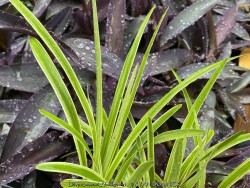

Variegated Liriope (Liriope muscari 'Variegata') grows to form a dense, dark green, grass-like groundcover in medium to full shade. As one of the very best "dry-shade" plants, it has environmental and economic traits that can help conserve water and lower your water bill! Plantings can thrive for decades if in the right spot; there is no such thing as overcrowding for Liriope. When planted in mass, growth is slow at first but eventually a cake-like rhizome system will form and completely smother out any weeds and compete well with trees for water and nutrients. Even under the most hostile conditions such as huge silver maple and pin oak trees, liriope not only survives but thrives. While Big Blue Liriope can tolerate full sun, they prefer part to full shade. Sun burning is possible with temperatures over 100° and there are better plants to use in hot areas. Liriope has no insect or disease problems, will survive droughts, short-term floods and cold winters. In the winter, it will stay green until 0 degrees F and be completely evergreen some winters. Liriope also thrives in summer with the worst heat and humidity even in the Southeast and Southwest! Liriope is tolerant of a wide range of soil types but prefers clay/loam and will display best growth in fertile soils with average water but extremely drought tolerant in shaded areas! For the home garden, the species spreads slowly so you shouldn't leave very much room in-between Liriope plants or you will be waiting many years for the patch to fill in. Weeds can be a problem in that open area between plants if spacing is too wide. We recommend 12-18" spacing for a larger area. The only problem we have seen is a mysterious crown-rot disease in well-irrigated gardens. This liriope (Liriope muscari 'Variegata') does not spread very quickly or much at all compared to Spreading Liriope / Monkey Grass (Liriope spicata) This is a real trooper for the dry shade garden!


Liriope (Liriope spitica) grows to form a dense, dark green, grass-like groundcover / turf in medium to full shade. (also called "Lilyturf"). As one of the very best "dry-shade" plants, it has environmental and economic traits that cannot be disputed. A typical homeowner will save hundreds of dollars a year on lawn maintenance costs. Large turflike installations can save thousands of dollars per year. Even under the most hostile conditions such as huge silver maple and pin oak trees, liriope not only survives but thrives. Liriope has no insect or disease problems, will survive droughts, short-term floods and cold winters. Liriope has a very low water requirement and a deep root system that allows it to draw water from a large area. Liriope thrives on only 1 deep watering per month in the summer to stay green. In the winter, it will stay green until zero degrees and be completely evergreen some winters. If the top Liriope grows to form a dense groundcover / turf in medium to full shade. Liriope requires no mowing maintenance (monthly mowing is optional to achieve 4" height) Un-mowed, it will grow uniformly 8-10" and appear like a lawn from a distance. Fewer weed problems occur; the dense growth of liriope grass smothers out existing weeds and prevents the germination of new seeds. The soft texture and medium green color are great assets; evergreen to 0ºF, survives -20. Liriope grows in zones 5-9; tolerates cold in the winter and heat / humidity in the summer. Liriope is tolerant of a wide range of soil types but prefers clay/loam and will display best growth in fertile soils with average water but extremely drought tolerant in shaded areas! For the home garden, the species is generally too aggressive to mix with other plants. Use as a groundcover or lawn substitute for dry-shade.
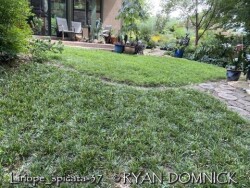

Liriope (Liriope spitica) grows to form a dense, dark green, grass-like groundcover / turf in medium to full shade. (also called "Lilyturf"). As one of the very best "dry-shade" plants, it has environmental and economic traits that cannot be disputed. A typical homeowner will save hundreds of dollars a year on lawn maintenance costs. Large turflike installations can save thousands of dollars per year. Even under the most hostile conditions such as huge silver maple and pin oak trees, liriope not only survives but thrives. Liriope has no insect or disease problems, will survive droughts, short-term floods and cold winters. Liriope has a very low water requirement and a deep root system that allows it to draw water from a large area. Liriope thrives on only 1 deep watering per month in the summer to stay green. In the winter, it will stay green until zero degrees and be completely evergreen some winters. If the top Liriope grows to form a dense groundcover / turf in medium to full shade. Liriope requires no mowing maintenance (monthly mowing is optional to achieve 4" height) Un-mowed, it will grow uniformly 8-10" and appear like a lawn from a distance. Fewer weed problems occur; the dense growth of liriope grass smothers out existing weeds and prevents the germination of new seeds. The soft texture and medium green color are great assets; evergreen to 0ºF, survives -20. Liriope grows in zones 5-9; tolerates cold in the winter and heat / humidity in the summer. Liriope is tolerant of a wide range of soil types but prefers clay/loam and will display best growth in fertile soils with average water but extremely drought tolerant in shaded areas! For the home garden, the species is generally too aggressive to mix with other plants. Use as a groundcover or lawn substitute for dry-shade.
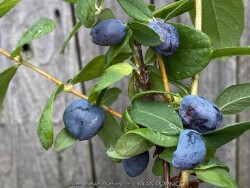

Also called Honeyberries, Japanese Haskap, or Yezberry® (Lonicera caerulea), these shrubs are easy-to-grow fruiting plants developed for their large, delicious blue fruit. Yezberry® are extremely cold hardy and able to bear fruit in zones 3-7. Plant with another Yezberry® variety for an abundant fruit set on both plants. However, as an ornamental shrub, late summer Kansas heat stress will likely cause partial to complete defoliation. This does not affect the fruit quality or overall health of the shrub as the flower buds for next year are already formed. Ultra cold-hardy plants from northern climates normally dislike our long hot humid summers; although we are on the Southern edge of this plants adaptability, it still survives reasonably well here. Look for a cold microclimate planting location such as East or North exposure. In Eastern Kansas, typically our 40 inches of rainfall is sufficient without extra water. All Proven Winners® plants are legally propagated, healthy and vigorous, true to name, and tagged with color pictures and growing information.
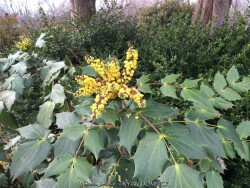

Leatherleaf Mahonia (Mahonia bealei) is a slow-growing coarse-textured evergreen shrub with bright green holly-like leaflets. The leaves are prickly and make a fine barrier or specimen plant. Native to continental climates in China, Mahonia bealei can be invasive in Eastern US woods where its shade tolerance and slow evergreen growth eventually shade out native plants. This is not a problem in Kansas due to extreme winters and dryer conditions. Flowering tries to occur in mid to late winter in Kansas but are usually frozen before they can open. During a "once in 5 years" mild winter if temperatures stay above 0 degrees F, fragrant, lemon-yellow flowers do develop. Even more rare is to have a long enough warm spell in winter to allow the beautiful blackish-blue fruit to develop afterward. If they do, they will be enjoyed by birds but any small seedlings that do germinate are killed by ground freezes the next winter. Leatherleaf Mahonia is very drought tolerant when established making it an ideal dry-shade plant; the 40 inches of typical rainfall in Eastern Kansas is sufficient if planted in rototilled soils. This could be one of the most cold-tolerant broadleaf evergreens available! It survived -16 degrees F and a week of single digit highs in February, 2021 with no damage. It even maintains bright green foliage in winter opposed to a dingy brownish-green like some evergreens. In Eastern Kansas, this species performs WELL with just about everything nature has to challenge it! Heat and drought are tolerated if in shade or morning sun. Cold tolerance is no problem. Invasiveness is not a problem. No disease or pest problems. And again, this is a great evergreen plant for difficult dry-shade situations under mature trees where lawn won't grow.
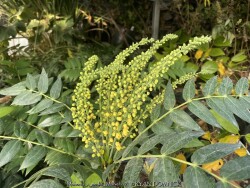

Leatherleaf Mahonia (Mahonia x media 'Marvel') is a slow-growing coarse-textured evergreen shrub with bright green holly-like leaflets. The leaves are prickly and make a fine barrier or specimen plant. Native to continental climates in China, Mahonia bealei can be invasive in Eastern US woods where its shade tolerance and slow evergreen growth eventually shade out native plants. This is not a problem in Kansas due to extreme winters and dryer conditions. Flowering tries to occur in mid to late winter in Kansas but are usually frozen before they can open. During a "once in 5 years" mild winter if temperatures stay above 0 degrees F, fragrant, lemon-yellow flowers do develop. Even more rare is to have a long enough warm spell in winter to allow the beautiful blackish-blue fruit to develop afterward. If they do, they will be enjoyed by birds but any small seedlings that do germinate are killed by ground freezes the next winter. Leatherleaf Mahonia is very drought tolerant when established making it an ideal dry-shade plant; the 40 inches of typical rainfall in Eastern Kansas is sufficient if planted in rototilled soils. This could be one of the more cold-tolerant broadleaf evergreens available! 'Marvel' survived -16 degrees F and a week of single digit highs in February, 2021 but with complete foliage loss. It even maintains bright green foliage in winter opposed to a dingy brownish-green like some evergreens. In Eastern Kansas, this species performs WELL with just about everything nature has to challenge it! Heat and drought are tolerated if in shade or morning sun. Cold tolerance is no problem. Invasiveness is not a problem. No disease or pest problems. And again, this is a great evergreen plant for difficult dry-shade situations under mature trees where lawn won't grow. Mahonia x media 'Marvel' is an improved cultivar that is more compact than other varieties. Evergreen foliage is a medium glossy green and more fine-textures compared to the species. Frond-like leaves develop in whorls and are arranged along coarsely branched stems creating an architectural effect. It is unknown at this point (2022) if flowers and fruit will develop here in Kansas zone 6a but it is doubtful seeing how it tries to bloom in the winter similar to the species.
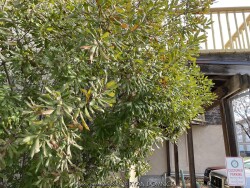

Northern Bayberry, is also known as Myrica pennsylvanica
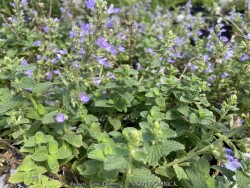

Nepeta (Catmint) Is one of the most adaptable, permanent perennials available in our climate and in your landscape! Definitely a "once it's their plant if there forever". Originally native to the Caucasus, Iran, Iraq, Turkey, there are numerous cultivars now with improved flowering and growth habit. Generally, the mint green foliage is fine textured and compact. Spring emergence in Kansas zone 6a is very early (usually in March) and will tolerate late freezes. This creates very early season interest in the garden while other plants are still dormant. Usually within a month of emerging, lavender-blue flowers cover the plant for up to six weeks. Pollinators enjoy the feast especially when catmint is used as a mass planting groundcover. Following spring flowering, many varieties develop attractive foliage and continual sporadic flowering. Some varieties have another big flower show in the fall especially if they are trimmed back and deadheaded once in late summer. Foliage is persistent and remains attractive late into the fall down to about 20° F providing late-season interest. Winter dried foliage is a somewhat attractive light gray and will eventually need to be cut or mowed to the ground before new growth emerges in the spring. Catmint is tolerant of almost any kind of soil including clay but will not tolerate poorly drained soil. Frequent watering is OK in normal garden soils but there is a risk of excessive growth and flopping. Catmint looks best in full sun but will still flower and look decent with part shade or 1/2 day full sun. This makes it adaptable to any side of the house even called northside if it gets full sun by mid-summer when the sun angle gets high. Cold hardiness or heat stress is not a problem at all in zone 6. Combine with just about any other perennial or shrub with a different flower and leaf color. It's hard to imagine a perennial or pollinator garden in Kansas without Catmint! Contrary to popular belief, cats do not destroy or eat this plant but may be attracted to it and create a nest beside it. They are really after catnip, a closely related plant. Nepeta 'Cat's Pajamas' is a long blooming perennial that's perfect in small areas of the landscape. Indigo blue flowers are produced all the way from the soil to the tips, providing an intense splash of color when it's in bloom. Rosy purple calyxes extend the color when the blooms are past peak. All Proven Winners® plants are legally propagated, healthy and vigorous, true to name, and tagged with color pictures and growing information.
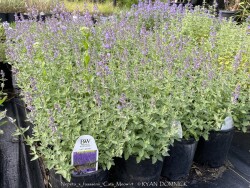

Nepeta (Catmint) Is one of the most adaptable, permanent perennials available in our climate and in your landscape! Definitely a "once it's their plant if there forever". Originally native to the Caucasus, Iran, Iraq, Turkey, there are numerous cultivars now with improved flowering and growth habit. Generally, the mint green foliage is fine textured and compact. Spring emergence in Kansas zone 6a is very early (usually in March) and will tolerate late freezes. This creates very early season interest in the garden while other plants are still dormant. Usually within a month of emerging, lavender-blue flowers cover the plant for up to six weeks. Pollinators enjoy the feast especially when catmint is used as a mass planting groundcover. Following spring flowering, many varieties develop attractive foliage and continual sporadic flowering. Some varieties have another big flower show in the fall especially if they are trimmed back and deadheaded once in late summer. Foliage is persistent and remains attractive late into the fall down to about 20° F providing late-season interest. Winter dried foliage is a somewhat attractive light gray and will eventually need to be cut or mowed to the ground before new growth emerges in the spring. Catmint is tolerant of almost any kind of soil including clay but will not tolerate poorly drained soil. Frequent watering is OK in normal garden soils but there is a risk of excessive growth and flopping. Catmint looks best in full sun but will still flower and look decent with part shade or 1/2 day full sun. This makes it adaptable to any side of the house even called northside if it gets full sun by mid-summer when the sun angle gets high. Cold hardiness or heat stress is not a problem at all in zone 6. Combine with just about any other perennial or shrub with a different flower and leaf color. It's hard to imagine a perennial or pollinator garden in Kansas without Catmint! Contrary to popular belief, cats do not destroy or eat this plant but may be attracted to it and create a nest beside it. They are really after catnip, a closely related plant. Nepeta x faassenii 'Cats Meow' in a new variety from Proven Winners® No catmint is a more beautiful, uniform grower than 'Cat's Meow' Nepeta. Its flowers are dense and colorful, and its habit is more refined. Plus, it stands strong with no flopping, getting wider and growing to a broad mound as the season progresses. All Proven Winners® plants are legally propagated, healthy and vigorous, true to name, and tagged with color pictures and growing information.
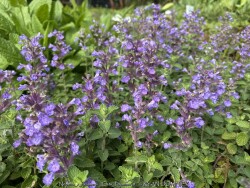

Nepeta (Catmint) Is one of the most adaptable, permanent perennials available in our climate and in your landscape! Definitely a "once it's their plant if there forever". Originally native to the Caucasus, Iran, Iraq, Turkey, there are numerous cultivars now with improved flowering and growth habit. Generally, the mint green foliage is fine textured and compact. Spring emergence in Kansas zone 6a is very early (usually in March) and will tolerate late freezes. This creates very early season interest in the garden while other plants are still dormant. Usually within a month of emerging, lavender-blue flowers cover the plant for up to six weeks. Pollinators enjoy the feast especially when catmint is used as a mass planting groundcover. Following spring flowering, many varieties develop attractive foliage and continual sporadic flowering. Some varieties have another big flower show in the fall especially if they are trimmed back and deadheaded once in late summer. Foliage is persistent and remains attractive late into the fall down to about 20° F providing late-season interest. Winter dried foliage is a somewhat attractive light gray and will eventually need to be cut or mowed to the ground before new growth emerges in the spring. Catmint is tolerant of almost any kind of soil including clay but will not tolerate poorly drained soil. Frequent watering is OK in normal garden soils but there is a risk of excessive growth and flopping. Catmint looks best in full sun but will still flower and look decent with part shade or 1/2 day full sun. This makes it adaptable to any side of the house even called northside if it gets full sun by mid-summer when the sun angle gets high. Cold hardiness or heat stress is not a problem at all in zone 6. Combine with just about any other perennial or shrub with a different flower and leaf color. It's hard to imagine a perennial or pollinator garden in Kansas without Catmint! Contrary to popular belief, cats do not destroy or eat this plant but may be attracted to it and create a nest beside it. They are really after catnip, a closely related plant. Nepeta x faassenii 'Cats Pajamas' in a new variety from Proven Winners® Unlike older varieties that only produce flowers at the top of the stems, this improved Catmint has blooms from the soil to the tips of the stems. Even when the flowers are past peak, the color of the rosy purple calyxes give your garden an additional splash of color. Compared to "Cats Meow", its flowers are the same but overall plant height is about 1/2-2/3rds. Plus, it stands strong with no flopping, getting wider and growing to a broad mound as the season progresses. All Proven Winners® plants are legally propagated, healthy and vigorous, true to name, and tagged with color pictures and growing information. PERENNIAL OF THE YEAR in 2021!
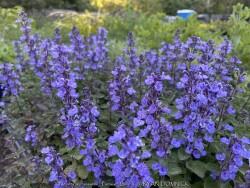

Nepeta (Catmint) Is one of the most adaptable, permanent perennials available in our climate and in your landscape! Definitely a "once it's their plant if there forever". Originally native to the Caucasus, Iran, Iraq, Turkey, there are numerous cultivars now with improved flowering and growth habit. Generally, the mint green foliage is fine textured and compact. Spring emergence in Kansas zone 6a is very early (usually in March) and will tolerate late freezes. This creates very early season interest in the garden while other plants are still dormant. Usually within a month of emerging, lavender-blue flowers cover the plant for up to six weeks. Pollinators enjoy the feast especially when catmint is used as a mass planting groundcover. Following spring flowering, many varieties develop attractive foliage and continual sporadic flowering. Some varieties have another big flower show in the fall especially if they are trimmed back and deadheaded once in late summer. Foliage is persistent and remains attractive late into the fall down to about 20° F providing late-season interest. Winter dried foliage is a somewhat attractive light gray and will eventually need to be cut or mowed to the ground before new growth emerges in the spring. Catmint is tolerant of almost any kind of soil including clay but will not tolerate poorly drained soil. Frequent watering is OK in normal garden soils but there is a risk of excessive growth and flopping. Catmint looks best in full sun but will still flower and look decent with part shade or 1/2 day full sun. This makes it adaptable to any side of the house even called northside if it gets full sun by mid-summer when the sun angle gets high. Cold hardiness or heat stress is not a problem at all in zone 6. Combine with just about any other perennial or shrub with a different flower and leaf color. It's hard to imagine a perennial or pollinator garden in Kansas without Catmint! Contrary to popular belief, cats do not destroy or eat this plant but may be attracted to it and create a nest beside it. They are really after catnip, a closely related plant. Nepeta faassenii 'Purrsian Blue' was introduced by Walter's Garden, Inc. This selection has an improved tidy habit, though it is a bit smaller and more compact in size overall than others. This is a very floriferous selection whose flower power is amplified by its having its flowers spaced closely together on the stems. Periwinkle blue flowers are coddled by dark purple calyxes just above the aromatic foliage from early summer into early fall.
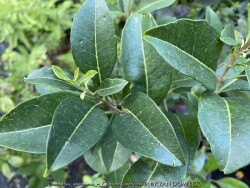

Devilwood (Osmanthus americanus / Cartrema americana) has very hard and dense wood, hence the name. It is a slow-growing evergreen shrub or small tree native to southeastern North America and Mexico. Bright green simple leaves emerge in spring turning deeper green in summer. Cream white flowers borne on separate trees and female trees produce abundant blue/black fruit. Growth habit is somewhat open so don't count on it to provide screening or density. Grows in sun or shade but in the northern part of its range, growth is too slow and sparse in the shade. Devilwood grows in most soils including moist ones and occasional flooding. This making it an ideal rain garden plant. Becoming more drought tolerant when established, our 40 inches of typical rainfall in Eastern Kansas is sufficient if planted in good soils. The cold hardiness is surprising: as a zone 5, this could be one of the most cold-tolerant broadleaf evergreens trees available! It survived -16 degrees F and a week of single digit highs in February, 2021 with no damage. It even maintains bright green foliage in winter opposed to a dingy brownish-green like some evergreens. Useful in the garden as a background evergreen shrub or small tree. Sold as Osmanthus americanus, Cartrema americana is technically it's new botanical name.
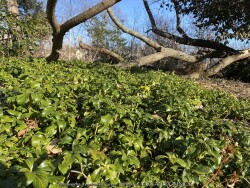

Green Sheen Japanese Pachysandra, is also known as Pachysandra terminalis 'Green Sheen'
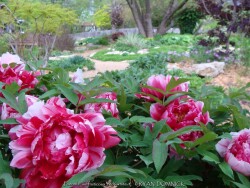

Tree Peonies (Paeonia suffruiticosa) are larger, woody relatives of the common herbaceous (perennial) peony. It does not die to the ground each winter, instead growing up to 3-5 feet after many years. Tree peonies have been in culture in China for millennia. Most "tree" peonies are really just shrubs and are grafted to the rootstock of herbaceous peonies. Peonies, along with roses are one of the most universally well-known flowers. The toughness and durability of this plant can be seen in cemeteries or around abandoned houses, surviving decades even 100 years or more without care. Both tree and herbaceous peonies are native to China in cold continental climate areas but also do well in Kansas. Large flowers come in different shades of white, red, and pink. Blooming only lasts about 3-7 days and can be short-lived if a thunderstorm happens during the second day of blooming when petals are fully open. The foliage is especially attractive in spring when unfurling into a flat, rich green and remains attractive throughout summer. Usually, by early fall, foliage is tattered from drought stress and diseases with no appreciable fall color. This has no ill effect on the health of the plant as it is already set its growth buds for next year. In northern areas (USDA zones 3-6), Peony foliage lasts all summer and turns brilliant red and orange colors in the fall. Due to its need for cold winters, peonies will not grow well further south than zone 8b. Due to its cold tolerance, peonies may be grown in above-ground pots or raised planters year-round. Ultra cold-hardy plants from northern climates normally dislike our long hot humid summers; although we are on the Southern edge of this plant's adaptability, it still survives reasonably well here. Several have been alive for over 15 years and bloom like clockwork each spring here in our Lawrence, KS display garden.


Russian sage (Perovskia atriplicifolia) is a perfectly well-adapted plant from Afghanistan, Pakistan, and Central Asia. It is the perfect match to hot Kansas summers, cold winters, rocky alkaline soils, and drought. Fine-textured foliage is upright and shrub-like consisting of a mint green to blush green color. Lavender to bluish flowers emerging in mid-summer are extremely long-lasting. In fall, Russian sage foliage dies back with the first hard freeze and becomes a whitish-gray color adding awesome winter interest. Imagine this combined with ornamental grasses or bright winter-colored plants like Color Guard Yucca. The only maintenance is cutting the plant back to you about 6 to 8 inches in the spring. New buds emerge from the root system and lower parts of the woody growth. New cultivars of Russian sage do not spread by rhizomes like the species. Russian sage thrives in dry well-drained soils with plenty of full sun and air circulation. They are suitable for hot west or south exposures, berms, parking lot islands, hell strips along roads, and other inhospitable locations. They tolerate poor soil including rock, sand, clay, and alkalinity. They do not tolerate poor drainage and will be floppy even in part shade. Russian sage flowers are highly attractive to honeybees. There are several improved cultivars with improved blooming, improved growth habit, and elimination of spreading. Blue Jean Baby Russian Sage (Perovskia atriplicifolia 'Blue Jean Baby') is a wonderful compact, non-spreading, and non-flopping variety. Lavender blue flowers held in smoky purple calyxes bloom for a long period starting in midsummer, with the color from the calyxes extending appeal into fall. Blue Jean Baby a Walters Gardens Inc. introduction.


Russian sage (Perovskia atriplicifolia) is a perfectly well-adapted plant from Afghanistan, Pakistan, and Central Asia. It is the perfect match to hot Kansas summers, cold winters, rocky alkaline soils, and drought. Fine-textured foliage is upright and shrub-like consisting of a mint green to blush green color. Lavender to bluish flowers emerging in mid-summer are extremely long-lasting. In fall, Russian sage foliage dies back with the first hard freeze and becomes a whitish-gray color adding awesome winter interest. Imagine this combined with ornamental grasses or bright winter-colored plants like Color Guard Yucca. The only maintenance is cutting the plant back to you about 6 to 8 inches in the spring. New buds emerge from the root system and lower parts of the woody growth. New cultivars of Russian sage do not spread by rhizomes like the species. Russian sage thrives in dry well-drained soils with plenty of full sun and air circulation. They are suitable for hot west or south exposures, berms, parking lot islands, hell strips along roads, and other inhospitable locations. They tolerate poor soil including rock, sand, clay, and alkalinity. They do not tolerate poor drainage and will be floppy even in part shade. Russian sage flowers are highly attractive to honeybees. There are several improved cultivars with improved blooming, improved growth habit, and elimination of spreading. "Tough as steel! A new seed introduction by PanAm Seed with a sturdy, controlled habit in the landscape. 'Blue Steel' combines the best summer-blooming lavender-blue colour with outstanding late-season garden performance and has aromatic, silvery foliage carrying clouds of small blue flowers on strong silver stems that do not break or split easily. It is very hardy and Heat/drought tolerant." - PanAm Seed